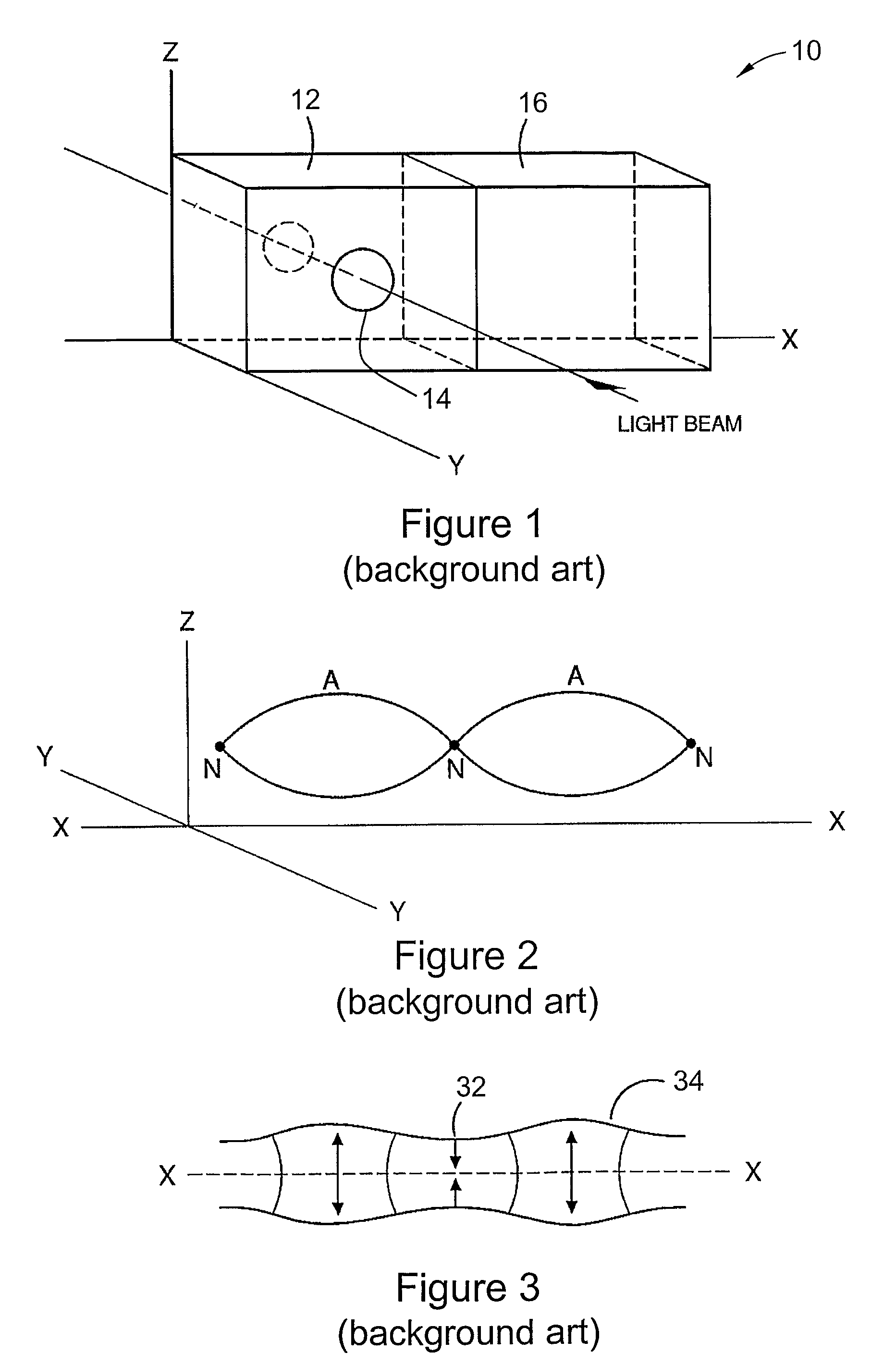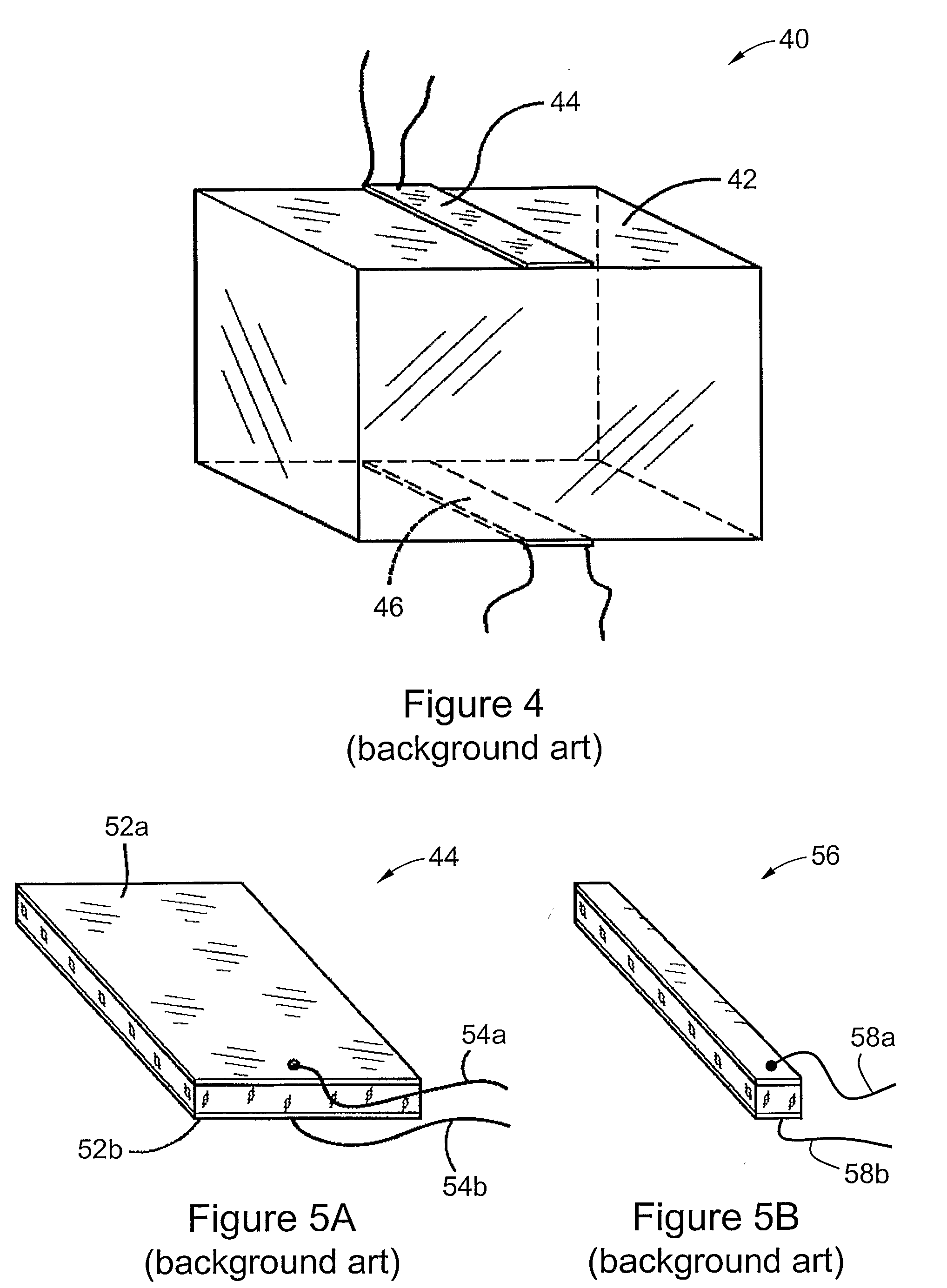Photoelastic modulator
a modulator and photoelastic technology, applied in the field of spectroscopy and spectropolarimetry, can solve the problems of affecting the efficiency of the modulator, so as to reduce the reduce the unwanted effect of other modes and reflections, and reduce the effect of interfering vibration and reflection
- Summary
- Abstract
- Description
- Claims
- Application Information
AI Technical Summary
Benefits of technology
Problems solved by technology
Method used
Image
Examples
first embodiment
[0064]FIG. 6 is a schematic view of a single-block full wave PEM body 60 according to the present invention. The PEM body 60 comprises a solid block of optical material comprising, in this embodiment, a rectangular block of fused silica. The PEM body 60 includes a rectangular recess 62, formed by masking the upper surface 64 of PEM body 60 and removing material with a particle jet etching (i.e. essentially sand blasting) or chemical etching. Geometrically, the recess 62 is the opposite of a mesa. The size of recess 62 is less than that of the transducer to be affixed in length (i.e. in the Y direction) but wider than the transducer (i.e. in the X direction).
[0065]If the PEM body is, instead, to be used as part of a two block PEM, the material of the two blocks is preferably a solid material of the same chemical constituent. However, only the optical block is in such embodiments of high optical quality such as in spectral coverage, and with very low residual birefringence.
[0066]The r...
second embodiment
[0067]FIG. 7 is a single-block half-wave mode PEM body 70 according to the present invention. The PEM body 70, like PEM body 60 of FIG. 6, comprises a solid block of optical material comprising a rectangular block of fused silica. PEM body 70 includes a recess 72, comparable to recess 62 of PEM body 60 of FIG. 6, formed in upper surface 74. In addition, however, PEM body 70 includes a second recess 76 formed in bottom surface 78 of the PEM body 70.
[0068]The ultimate PEM comprises PEM body 60 and a piezoelectric transducer (such as transducer 44 of FIGS. 4 and 5A). FIG. 8 is a schematic plan view of PEM body 60 (or equivalently PEM body 70), with a piezoelectric transducer 80 (with electrical leads 82, 84) attached thereto over recess 62. The transducer 80 can be a single slab of piezoelectric material (such as PZT-5 ceramic) but most conveniently either a number of separated narrow strips or a multiple strip array in a single piece of piezoelectric material. After the PEM's sensor (...
third embodiment
[0075]FIG. 9 is a schematic view of a single-block half-wave mode PEM body 90 according to the present invention. The PEM body 90 comprises a solid block of optical material comprising a rectangular block of fused silica. The PEM body 90 includes an H shaped recess 92 in its upper surface 94; this shape leaves non-recess portions in the form of contact pads 96a, 96b extending inwardly towards the centre of the recess 92. These contact pads 96a, 96b provide additional contact areas for a piezoelectric transducer, and contact areas for the sensor. This provides a purely extension mode of sensing that minimises the detection of reflections inside the block 90 that might otherwise be transferred to the sensor as noise.
[0076]This embodiment of PEM body is most particularly adapted for use in high stress conditions. PEMs operating in long optical wavelengths, that is from the medium to the far-infrared optical spectral region, requires a strong strain induced birefringence to create suffi...
PUM
| Property | Measurement | Unit |
|---|---|---|
| depth | aaaaa | aaaaa |
| mechanical coupling | aaaaa | aaaaa |
| pressure | aaaaa | aaaaa |
Abstract
Description
Claims
Application Information
 Login to View More
Login to View More - R&D
- Intellectual Property
- Life Sciences
- Materials
- Tech Scout
- Unparalleled Data Quality
- Higher Quality Content
- 60% Fewer Hallucinations
Browse by: Latest US Patents, China's latest patents, Technical Efficacy Thesaurus, Application Domain, Technology Topic, Popular Technical Reports.
© 2025 PatSnap. All rights reserved.Legal|Privacy policy|Modern Slavery Act Transparency Statement|Sitemap|About US| Contact US: help@patsnap.com



